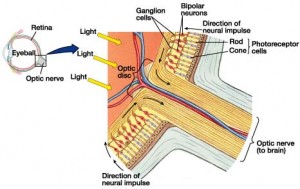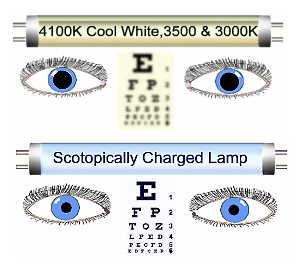What is Scotopically Rich Lighting?
Often we talk to customers about Scotopically Rich Lighting, and for those who have never heard the term before it can be a little confusing. Manufacturers have performed studies for year on the photopic lumens that are produced by a light source such as a light bulb. The photopic lumens are a measurement of brightness by a lumen meter. This measurement can be translated by how light is percieved the cones in the human eye. These light meters completely ignore the effect of rod activated vision (scotopic). As a result, lighting practice accepted this single sensitivity function because it was erroneously assumed that the more light sensitive rods only functioned at very dim light levels.
How the eye perceives light
 Light arrives at our eye from all portions of an illuminated space. At the back of the eye there is a light sensitive membrane called the retina which contains millions of very tiny light receptors. These receptors convert light into electrified signals that are sent to the vision centers of the brain. The retina contains two major categories of light receptors (photoreceptors) called the cones and rods because of their geometric shapes. The central part of the retina, the fovea, contains only cones. In the rest of the retina there are both rods and cones, with the number of rods dominating the cones by about 10 to 1.
Light arrives at our eye from all portions of an illuminated space. At the back of the eye there is a light sensitive membrane called the retina which contains millions of very tiny light receptors. These receptors convert light into electrified signals that are sent to the vision centers of the brain. The retina contains two major categories of light receptors (photoreceptors) called the cones and rods because of their geometric shapes. The central part of the retina, the fovea, contains only cones. In the rest of the retina there are both rods and cones, with the number of rods dominating the cones by about 10 to 1.
Scientists have recently discovered that the rods in the human eye can perform in dim light levels as well as interior lighting levels of those commonly found in office environments and stores. These rods are sensitive to light sources that emit bluish-white color tones like those found in higher kelvin temperature fluorescent light bulbs. Vision specialists put both functions of the rods and the cones together to measure a complete value of light sensitivity know as a Scotopic/Photopic (S/P) Ratio. The S/P Ratio of most fluorescent and incandescent lamps is very low. For example, a Warm White Bulb has an S/P Ratio of 1:14 while a full spectrum 5000K lamp lamp such as an Ultra 50 or Skybrite has a ration of 2:47. These number can be hard to understand, so lets look at it in a more simple light.

Lamps that are in the yellow kelvin temperature range 2700-4200 use primarily the cones in the eye. The pupil becomes enlarged to allow more light to enter the eye, and therefore causing more muscles in the eye to work harder to provide visual clarity. Lamps in the 5000 Kelvin range allow the rods to work better, which in turn constricts the pupil and allows for easier visual clarity which is a scotopic response. In otherwords, thwo light sources can have the same photopic lumens, but the lamps with higher scotopic values will apear to the eye as being percieved brighter. This scotopic response reduces visual fatigue, increase reading ability and reduces “disability glare”, especially in the electronic office.
Scotopically Rich Lighting Redues Fatigue and Glare
Disability glare is defined by the Illuminating Engineering Society as “glare resulting in reduced visual performance and visibility.” It is often accompanied by discomfort. Disability glare occurs as a result of “light scatter” in the eye. Light scatter is caused by imperfections in the optical media of the eye (the cornea & lens). These imperfections are common to some degree in everyone, and become more severe with age. The imperfections in the optical media cause a scattering of light rays coming from the non task area, causing undesirable light to fall on the central part of the retina (the fovea) where the task is focused. This causes a background haze of useless light on the central retina (the fovea) and reduces retinal contrast. Because the fovea contains only cones, just the photopic content of the ambient or general light is responsible for disability glare. Because people of age suffer from other conditions such as macular degeneration and cataracts, one must understand that the visible spectrum of light becomes diminished. In the case of a retail store or office, a customer may only see 60% of the visible light produced, therefore the increase of both photopic and scotopic light levels can be increasingly important to reduce glare and visual fatigue thus increasing productivity and sales.
Benfits of Scotopically Rich Lighting
- Reduces visual fatigue
- Elliminates disability glare
- Improved visual clarity
- Makes products appear more appealing
- Increased safety
- Objects appear much brighter
- Shows colors more accurately
- Greater energy efficiency
For more information on Scotopically Rich Lighting, view our website or call Synergy Lighting for a free consultation.
Phone: (941)-756-4844
Toll Free: (877) 220-5483
e-mail: sales@synergylightingusa.com


Currently there are no comments related to this article. You have a special honor to be the first commenter. Thanks!
You must be logged in to post the comment!